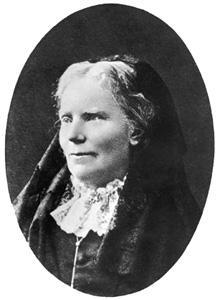Elizabeth Blackwell (First Female Doctor in the U.S)
 Elizabeth Blackwell (3 February 1821 – 31 May 1910) was the first female doctor in the United States.
Elizabeth Blackwell (3 February 1821 – 31 May 1910) was the first female doctor in the United States.
She was the first openly identified woman to graduate from medical school, a pioneer in educating women in medicine in the United States, and was prominent in the emerging women's rights movement.
Elizabeth Blackwell was born in Bristol, England and spent her early years living in a house on Wilson Street, off Portland Square, St Pauls, Bristol.
She was the third of nine children born to sugar refiner Samuel Blackwell and his wife, Hannah (née Lane). Blackwell could afford to give his numerous sons an education and also believed that his daughters should get the same education as boys, so he had them tutored by the house servants.
One night when Blackwell was 11, a fire destroyed her father's business. In 1832, the family emigrated to the United States and set up a refinery in New York City. The Blackwells were very religious Quakers. They believed that all men and women were equal in the eyes of God.
Due to their Quaker beliefs, the Blackwell family was anti-slavery. An opportunity was presented to Samuel Blackwell that allowed him to open a refinery in Ohio, where slaves would not be needed to harvest the sugar, so the Blackwells moved to Cincinnati. Three months after they moved, Elizabeth's father got very sick with biliary fever and died.
After the death of her father, Blackwell took up a career in teaching in Kentucky to make money to pay for medical school. Blackwell found this work unpleasant. Desiring to apply herself to the practice of medicine, she took up residence in a physician's household, using her time there to study from the family's medical library. She became active in the anti-slavery movement (as did her brother Henry Brown Blackwell who married Lucy Stone, a suffragist). Another brother, Samuel Charles Blackwell, married another important figure in women's rights, Antoinette Brown.
In 1845, she went to Asheville, North Carolina, where she read medicine in the home of Dr. John Dickson. Afterwards, she read with his brother Dr. Samuel Henry Dickson in Charleston, South Carolina.
She attended Geneva College in New York. She was accepted there — anecdotally, because the faculty put it to a student vote, and the students thought her application was a hoax — and braved the prejudice of some of the professors and students to complete her training. Blackwell is said to have replied that if the instructor was upset by the fact that Student No. 156 wore a bonnet, she would be pleased to remove her conspicuous headgear and take a seat at the rear of the classroom, but that she would not voluntarily absent herself from a lecture.
However, most of the faculty and students were not very polite to her. Blackwell's male peers treated her very rudely. On 11 January 1849, she became the first woman to earn a medical degree in the United States, and graduated, on 23 January 1849, first in her class.
Banned from practice in most hospitals, she was advised to go to Paris, France and train at La Maternité, but had to continue her training as a student midwife, not a physician. While she was there, her training was cut short when in November, 1849 she caught a serious eye infection, purulent ophthalmia, from a baby she was treating. She had her eye removed and replaced with a glass eye.
In 1857, Blackwell along with her sister Emily and Dr. Marie Zakrzewska, founded their own infirmary, named the New York Infirmary for Indigent Women and Children. During the American Civil War, Blackwell trained many women to be nurses and sent them to the Union Army. Many women were interested and received training at this time. After the war, Blackwell had time, in 1868, to establish a Women's Medical College at the Infirmary to train women, physicians, and doctors.
In 1857, Blackwell returned to England where she attended Bedford College for Women for one year. In 1858, under a clause in the 1858 Medical Act that recognized doctors with foreign degrees practising in Britain before 1858, she was able to become the first woman to have her name entered on the General Medical Council's medical register (1 January 1859).
In 1869, she left her sister Emily in charge of the college and returned to England. There, with Florence Nightingale, she opened the Women's Medical College. Blackwell taught at London School of Medicine for Women, which she had co-founded, and accepted a chair in gynecology. She retired a year later.
During her retirement, Blackwell still maintained her interest in the women's rights movement by writing lectures on the importance of education. Blackwell is credited with opening the first training school for nurses in the United States in 1873. She also published books about diseases and proper hygiene.
She was an early outspoken opponent of circumcision and in 1894 said that "Parents, should be warned that this ugly mutilation of their children involves serious danger, both to their physical and moral health." She was a proponent of women's rights and pro-life.
Her female education guide was published in Spain, as was her autobiography.
In 1856, she adopted Katherine "Kitty" Barry, an orphan of Irish origin, who was her companion for the rest of her life.
In 1907 Blackwell was injured in a fall from which she never fully recovered. She died on 31 May 1910 at her home in Hastings in Sussex after a stroke. She was buried in June 1910 in Saint Mun's churchyard at Kilmun on Holy Loch in the west of Scotland.